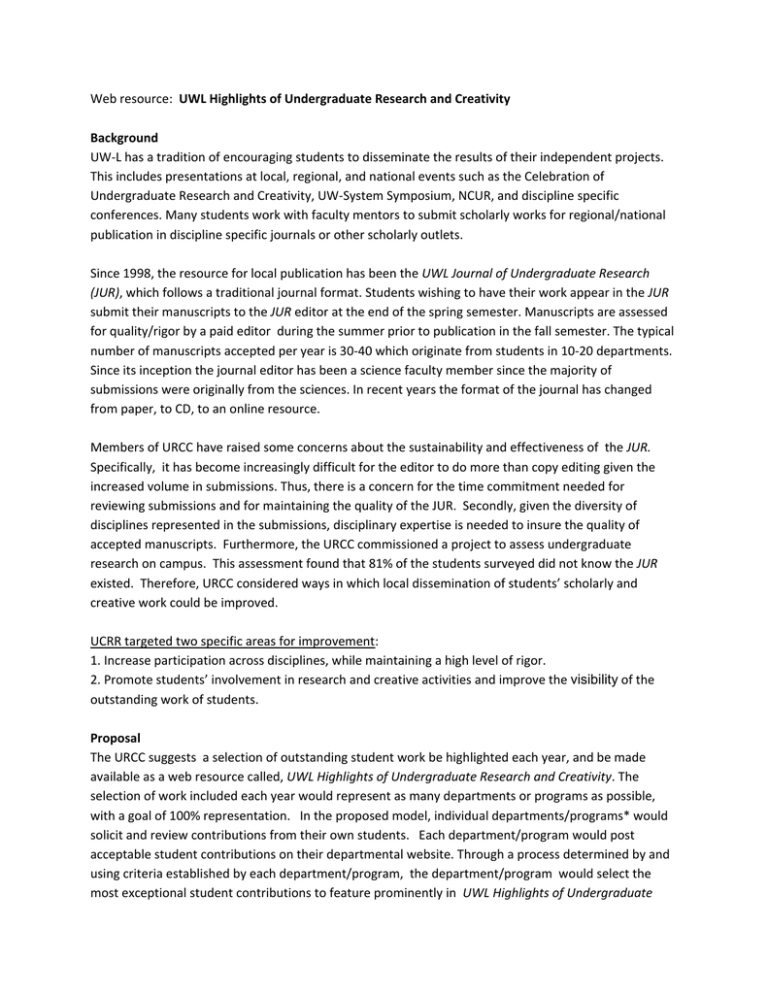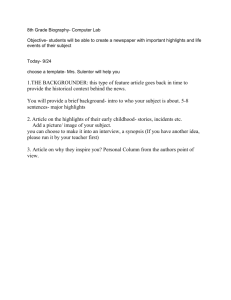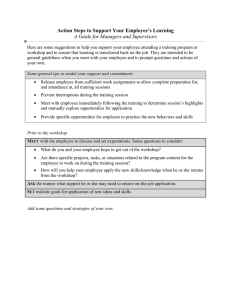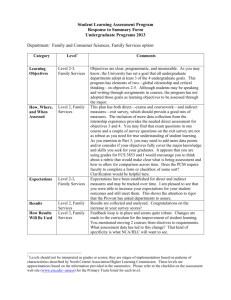UWL Highlights of Undergraduate Research and Creativity UW‐L has a tradition of encouraging students to disseminate the results of their independent projects. Background
advertisement

Web resource: UWL Highlights of Undergraduate Research and Creativity Background UW‐L has a tradition of encouraging students to disseminate the results of their independent projects. This includes presentations at local, regional, and national events such as the Celebration of Undergraduate Research and Creativity, UW‐System Symposium, NCUR, and discipline specific conferences. Many students work with faculty mentors to submit scholarly works for regional/national publication in discipline specific journals or other scholarly outlets. Since 1998, the resource for local publication has been the UWL Journal of Undergraduate Research (JUR), which follows a traditional journal format. Students wishing to have their work appear in the JUR submit their manuscripts to the JUR editor at the end of the spring semester. Manuscripts are assessed for quality/rigor by a paid editor during the summer prior to publication in the fall semester. The typical number of manuscripts accepted per year is 30‐40 which originate from students in 10‐20 departments. Since its inception the journal editor has been a science faculty member since the majority of submissions were originally from the sciences. In recent years the format of the journal has changed from paper, to CD, to an online resource. Members of URCC have raised some concerns about the sustainability and effectiveness of the JUR. Specifically, it has become increasingly difficult for the editor to do more than copy editing given the increased volume in submissions. Thus, there is a concern for the time commitment needed for reviewing submissions and for maintaining the quality of the JUR. Secondly, given the diversity of disciplines represented in the submissions, disciplinary expertise is needed to insure the quality of accepted manuscripts. Furthermore, the URCC commissioned a project to assess undergraduate research on campus. This assessment found that 81% of the students surveyed did not know the JUR existed. Therefore, URCC considered ways in which local dissemination of students’ scholarly and creative work could be improved. UCRR targeted two specific areas for improvement: 1. Increase participation across disciplines, while maintaining a high level of rigor. 2. Promote students’ involvement in research and creative activities and improve the visibility of the outstanding work of students. Proposal The URCC suggests a selection of outstanding student work be highlighted each year, and be made available as a web resource called, UWL Highlights of Undergraduate Research and Creativity. The selection of work included each year would represent as many departments or programs as possible, with a goal of 100% representation. In the proposed model, individual departments/programs* would solicit and review contributions from their own students. Each department/program would post acceptable student contributions on their departmental website. Through a process determined by and using criteria established by each department/program, the department/program would select the most exceptional student contributions to feature prominently in UWL Highlights of Undergraduate Research and Creativity. This resource would be similar in many respects to the current JUR. The differences between the two are addressed below. Highlights: The term Highlights, in place of Journal, was selected as a way to increase the overall number of students submitting a contribution. The term Highlights reduces the implication that presenting internally and publishing externally may be considered double‐publishing. Many students prefer to publish in discipline specific journals with their faculty mentors instead of presenting in the JUR. It would be desirable to have a UWL resource where students are comfortable presenting their work in addition to publishing externally. The term Highlights is consistent with encouraging the broadest range of student activities and forms of communication/dissemination. The URCC would work with individual campus departments/programs to help define the types of contributions (e.g. written, visual, audio) that would be acceptable, in order to achieve the goal of one exceptional student contribution per department* per year. We acknowledge that departments may have many excellent projects, one of which would be featured in the Highlights. Departments would be encouraged to highlight other outstanding projects prominently on their own websites and these would be linked to/from the Highlights. Review Process: The URCC suggests a review process that involves individual departments more directly. The current review process follows the path: student ‐‐> journal editor ‐‐> provost office. The proposed review process of Highlights follows the path: student ‐‐> department ‐‐> department website or provost office for posting in Highlights. The distinction is that review would be handled by individual departments instead of a centralized journal editor. As stated above, it is unrealistic for an editor from a single department to maintain a level of quality and rigor for contributions spanning a wide range of disciplines. The individual department is clearly the most qualified entity for maintaining rigor specific to its own discipline. No significant increase in workload for departments is anticipated, particularly for departments that have a history of students actively submitting to the JUR and presenting at the Celebration, or independent study/research students whose projects are already reviewed by department faculty. Departments would use their own method of reviewing student contributions and forward selected contributions to the Provosts Office for placement on the Highlights webpage. Ultimately, the URCC believes this process will lead to increases in efficiency, participation, and quality. Promotion and Visibility : The second area of improvement is to promote students’ engagement in scholarly and creative endeavors and to increase the visibility of these activities at UWL. Thus Highlights should be accessible, both in terms of presentation and literal accessibility. Accessing the current JUR requires foreknowledge of its existence, as navigation from the UWL homepage is a multiple step process. As indicated above, 81% of students surveyed about undergraduate research did not know the JUR existed. The web resource, Highlights, could provide a more direct and prominent location for featuring outstanding student projects. Such a web resource could also make our students’ work more visible to broader audiences, including prospective students and community members. The URCC believes that the combination of improved promotion/visibility and high quality of this format would compel greater participation of students and departments. All changes to dissemination procedures would be clarified on the Highlights homepage and in messages to faculty and students, targeting in particular those students participating in the Celebration. Assessment: Simple measures that may be used to assess the effectiveness of these proposed changes are: number of submitted contributions, number of participating departments, feedback from departments regarding workload, documenting number of webpage visits. * The term, department, is used to represent an organizational unit. Some departments (e.g. those providing different degrees or very large departments) may choose to be represented by subgroups. Each “subgroup” would be listed on the “Highlights” website each year and, so it is recommended these subgroups are large enough to be able to produce at least one project each year.





